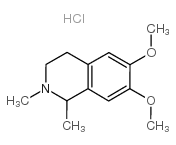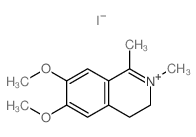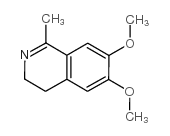5852-92-6
| 中文名 | 卡乃津盐酸盐 |
|---|---|
| 英文名 | 1,2-dimethyl-6,7-dimethoxy-1,2,3,4-tetrahydroisoquinoline hydrochloride |
| 英文别名 |
MFCD00035272
6,7-Dimethoxy-1,2-dimethyl-1,2,3,4-tetrahydro-isochinolin,Hydrochlorid Carnegine hydrochloride 3-(4-CHLOROPHENYL)IMINO-1-(1-PIPERIDYLMETHYL)INDOL-2-ONE (+-)-6,7-dimethoxy-1,2-dimethyl-1,2,3,4-tetrahydro-isoquinoline,hydrochloride CARNEGINE HCL 1,2-Dimethyl-6,7-dimethoxy-1,2,3,4-tetrahydroisoquinolineHCl |
| 沸点 | 302ºC at 760mmHg |
|---|---|
| 熔点 | 210-215ºC |
| 分子式 | C13H20ClNO2 |
| 分子量 | 257.75600 |
| 闪点 | 100.9ºC |
| 精确质量 | 257.11800 |
| PSA | 21.70000 |
| LogP | 2.99260 |
| 储存条件 | 密封储存,储存于阴凉、干燥的库房。远离腐蚀区。 |
| 计算化学 | 1、 疏水参数计算参考值(XlogP):2.1 2、 氢键供体数量:0 3、 氢键受体数量:3 4、 可旋转化学键数量:2 5、 互变异构体数量: 6、 拓扑分子极性表面积(TPSA):21.7 7、 重原子数量:16 8、 表面电荷:0 9、 复杂度:234 10、 同位素原子数量:0 11、 确定原子立构中心数量:1 12、 不确定原子立构中心数量:0 13、 确定化学键立构中心数量:0 14、 不确定化学键立构中心数量:0 15、 共价键单元数量:1 |
| 更多 | 1. 性状:白色或黄色结晶 2. 密度(g/mL,25℃):未确定 3. 相对蒸汽密度(g/mL,空气=1):未确定 4. 熔点(ºC):210-215 5. 沸点(ºC,常压):未确定 6. 沸点(ºC,0.07mmHg):未确定 7. 折射率(n20/D):未确定 8. 闪点(ºC):未确定 9. 比旋光度(º):未确定 10. 自燃点或引燃温度(ºC):未确定 11. 蒸气压(mmHg,20ºC):未确定 12. 饱和蒸气压(kPa,25ºC):未确定 13. 燃烧热(KJ/mol):未确定 14. 临界温度(ºC):未确定 15. 临界压力(KPa):未确定 16. 油水(辛醇/水)分配系数的对数值:未确定 17. 爆炸上限(%,V/V):未确定 18. 爆炸下限(%,V/V):未确定 19. 溶解性:溶于水 |
Synonym:N-Methylsalsolidine hydrochloride Section 2 - COMPOSITION, INFORMATION ON INGREDIENTS
Risk Phrases: 34 Section 3 - HAZARDS IDENTIFICATION EMERGENCY OVERVIEW
Causes burns. Potential Health Effects Eye: Causes eye burns. Skin: Causes skin burns. Ingestion: Causes gastrointestinal tract burns. The toxicological properties of this substance have not been fully investigated. Inhalation: Causes chemical burns to the respiratory tract. The toxicological properties of this substance have not been fully investigated. Chronic: Chronic exposure may cause effects similar to those of acute exposure. Section 4 - FIRST AID MEASURES Eyes: Immediately flush eyes with plenty of water for at least 15 minutes, occasionally lifting the upper and lower eyelids. Get medical aid immediately. Do NOT allow victim to rub eyes or keep eyes closed. Skin: In case of contact, immediately flush skin with plenty of water for at least 15 minutes while removing contaminated clothing and shoes. Get medical aid immediately. Wash clothing before reuse. Ingestion: If swallowed, do NOT induce vomiting. Get medical aid immediately. If victim is fully conscious, give a cupful of water. Never give anything by mouth to an unconscious person. Inhalation: Remove from exposure and move to fresh air immediately. If breathing is difficult, give oxygen. Get medical aid. Do NOT use mouth-to-mouth resuscitation. If breathing has ceased apply artificial respiration using oxygen and a suitable mechanical device such as a bag and a mask. Notes to Physician: Section 5 - FIRE FIGHTING MEASURES General Information: As in any fire, wear a self-contained breathing apparatus in pressure-demand, MSHA/NIOSH (approved or equivalent), and full protective gear. During a fire, irritating and highly toxic gases may be generated by thermal decomposition or combustion. Extinguishing Media: Use water spray, dry chemical, carbon dioxide, or chemical foam. Section 6 - ACCIDENTAL RELEASE MEASURES General Information: Use proper personal protective equipment as indicated in Section 8. Spills/Leaks: Vacuum or sweep up material and place into a suitable disposal container. Clean up spills immediately, observing precautions in the Protective Equipment section. Avoid generating dusty conditions. Provide ventilation. Section 7 - HANDLING and STORAGE Handling: Minimize dust generation and accumulation. Do not breathe dust, vapor, mist, or gas. Do not get in eyes, on skin, or on clothing. Keep container tightly closed. Do not ingest or inhale. Use only in a chemical fume hood. Discard contaminated shoes. Storage: Store in a cool, dry place. Store in a tightly closed container. Corrosives area. Section 8 - EXPOSURE CONTROLS, PERSONAL PROTECTION Engineering Controls: Facilities storing or utilizing this material should be equipped with an eyewash facility and a safety shower. Use adequate ventilation to keep airborne concentrations low. Exposure Limits CAS# 5852-92-6: Personal Protective Equipment Eyes: Wear appropriate protective eyeglasses or chemical safety goggles as described by OSHA's eye and face protection regulations in 29 CFR 1910.133 or European Standard EN166. Skin: Wear appropriate protective gloves to prevent skin exposure. Clothing: Wear appropriate protective clothing to prevent skin exposure. Respirators: Follow the OSHA respirator regulations found in 29 CFR 1910.134 or European Standard EN 149. Use a NIOSH/MSHA or European Standard EN 149 approved respirator if exposure limits are exceeded or if irritation or other symptoms are experienced. Section 9 - PHYSICAL AND CHEMICAL PROPERTIES Physical State: Crystals Color: white - yellow Odor: Not available. pH: Not available. Vapor Pressure: Not available. Viscosity: Not available. Boiling Point: Not available. Freezing/Melting Point: 210 - 215 deg C Autoignition Temperature: Not available. Flash Point: Not available. Explosion Limits, lower: Not available. Explosion Limits, upper: Not available. Decomposition Temperature: Solubility in water: soluble in water Specific Gravity/Density: Molecular Formula: C13H20NO2Cl Molecular Weight: 257.76 Section 10 - STABILITY AND REACTIVITY Chemical Stability: Not currently available. Conditions to Avoid: Dust generation. Incompatibilities with Other Materials: None reported. Hazardous Decomposition Products: Carbon monoxide, carbon dioxide. Hazardous Polymerization: Has not been reported Section 11 - TOXICOLOGICAL INFORMATION RTECS#: CAS# 5852-92-6 unlisted. LD50/LC50: Not available. Carcinogenicity: 1,2-Dimethyl-6,7-dimethoxy-1,2,3,4-tetrahydroisoquinoline hydrochloride - Not listed by ACGIH, IARC, or NTP. Section 12 - ECOLOGICAL INFORMATION Ecotoxicity: Fish: Pseudomonas putida: Section 13 - DISPOSAL CONSIDERATIONS Dispose of in a manner consistent with federal, state, and local regulations. Section 14 - TRANSPORT INFORMATION IATA Shipping Name: CORROSIVE SOLID, ACIDIC, ORGANIC, N.O.S. Hazard Class: 8 UN Number: 3261 Packing Group: III IMO Shipping Name: CORROSIVE SOLID, ACIDIC, ORGANIC, N.O.S. Hazard Class: 8 UN Number: 3261 Packing Group: III RID/ADR Shipping Name: CORROSIVE SOLID, ACIDIC, ORGANIC, N.O.S. Hazard Class: 8 UN Number: 3261 Packing group: III Section 15 - REGULATORY INFORMATION European/International Regulations European Labeling in Accordance with EC Directives Hazard Symbols: C Risk Phrases: R 34 Causes burns. Safety Phrases: S 25 Avoid contact with eyes. S 26 In case of contact with eyes, rinse immediately with plenty of water and seek medical advice. S 36/37/39 Wear suitable protective clothing, gloves and eye/face protection. S 45 In case of accident or if you feel unwell, seek medical advice immediately (show the label where possible). WGK (Water Danger/Protection) CAS# 5852-92-6: No information available. Canada None of the chemicals in this product are listed on the DSL/NDSL list. CAS# 5852-92-6 is not listed on Canada's Ingredient Disclosure List. US FEDERAL TSCA CAS# 5852-92-6 is not listed on the TSCA inventory. It is for research and development use only. SECTION 16 - ADDITIONAL INFORMATION N/A |
| 危害码 (欧洲) | C,Xi |
|---|---|
| 风险声明 (欧洲) | R34 |
| 安全声明 (欧洲) | S26-S45-S36-S37-S39 |
|
~94% 
5852-92-6 |
| 文献:Cui, Wenhua; Iwasa, Kinuko; Tokuda, Harukuni; Kashihara, Akiko; Mitani, Yosuke; Hasegawa, Tomoko; Nishiyama, Yumi; Moriyasu, Masataka; Nishino, Hoyoku; Hanaoka, Miyoji; Mukai, Chisato; Takeda, Kazuyoshi Phytochemistry, 2006 , vol. 67, # 1 p. 70 - 79 |
|
~% 
5852-92-6 |
| 文献:Phytochemistry, , vol. 67, # 1 p. 70 - 79 |
| 上游产品 2 | |
|---|---|
| 下游产品 0 | |



